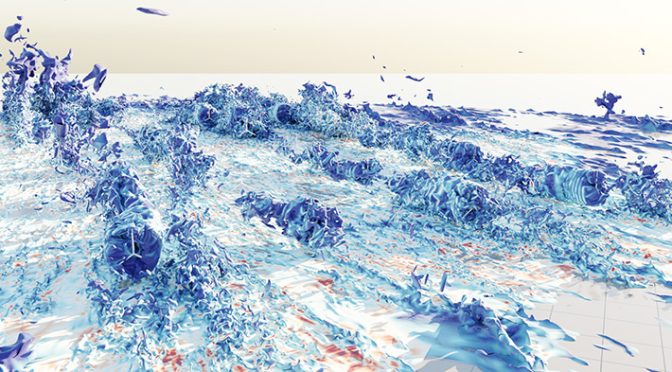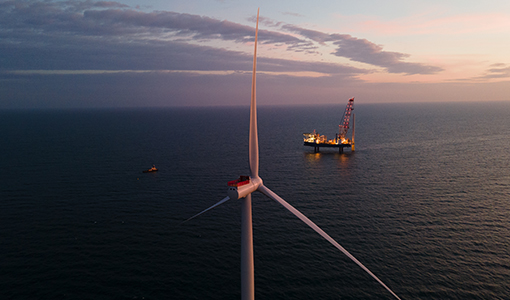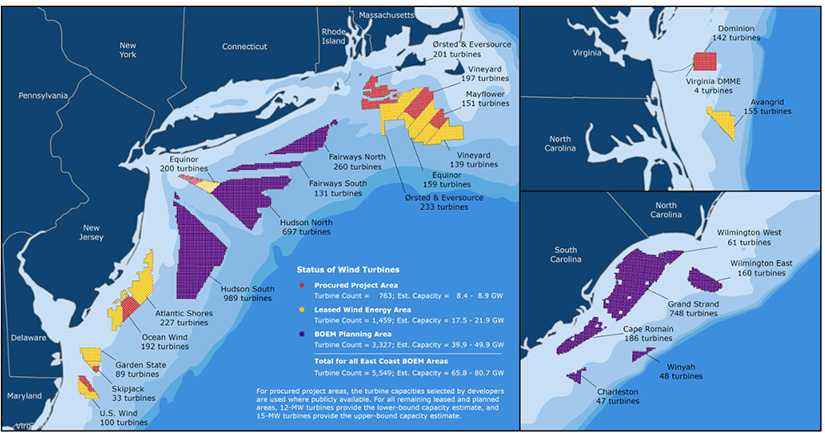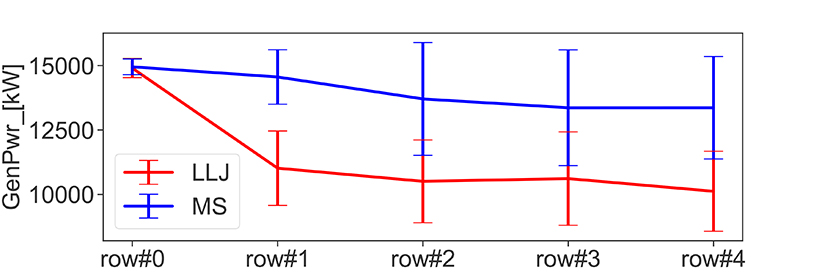
Low-level jet streams, also known as low-level jets (LLJs), behave in powerful and complex ways that can impact numerous American lives and livelihoods. Winds that blow along the U.S. coastline hit the homes of over 128 million people; that same wind energy has the potential to bring ashore a tidal wave of clean, renewable electricity to power these homes for more decades to come.

To harness this renewable energy resource, states along the Atlantic coast have pledged to deploy almost 20 gigawatts of wind energy by 2035, which will make wind a substantial source of energy for the nation’s most densely populated region. But understanding how LLJs behave can help unlock their full potential, and studying this invisible force has proved challenging for most researchers—until now.
With joint support from the National Offshore Wind Research and Development Consortium and GE Offshore Wind, researchers at the General Electric Global Research Center (GE-GRC) and the National Renewable Energy Laboratory (NREL) are studying the impact of LLJ behavior along the Atlantic coast on coastal wind farm installations to find critical insights for a burgeoning U.S. wind energy economy.

Using such cutting-edge simulations, the NREL/GE-GRC team’s LLJ research study has revealed a propensity for severe wake-induced power losses and increased loads on wind turbines in offshore deployment. Specifically, the Atlantic coast is known for strong LLJs with jet noses at heights comparable to the larger wind turbines planned for coastal offshore installations. These turbines could experience LLJ-driven forces capable of rapidly depleting their lifetimes, lowering their efficiency, and even causing turbine shutdowns. The high-fidelity simulations enabled coastal LLJ studies to also help researchers discover strategies to mitigate those LLJ impacts.

Illustrating power losses across a wind farm due to LLJs observed in the New York Bight region, the red lines of this chart correspond to simulations with LLJs and blue lines are from simulations with an ideal wind profile. Image from “Wind farm response to mesoscale-driven coastal low level jets: a multiscale large eddy simulation study” by T. Chatterjee, et al., in Journal of Physics: Conference Series, IOP Publishing
“Realizing the opportunity to make wide-ranging impact on offshore wind energy in the United States, we were able to bring together, in a short period of time, some highly capable researchers from GE Research and NREL,” said NREL researcher and co-PI of the project Shashank Yellapantula. “This team was able to accomplish all the goals originally proposed back in 2019.”
“This sort of public-private partnership allowed us to bring together the best minds across the fields of computational science and wind energy and leverage world-class modeling and simulation tools and computational infrastructure,” said Rick Arthur, director of computing at GE Research. “Such a collaboration is transformative, enabling not only insight into hidden potential problems but also consequent and viable solutions. The amplified power of this interdisciplinary, cross-industry collaboration cannot be overstated.”
Modeling Low-Level Jet Impacts
Solving today’s energy problems is a matter of having the ability to capture, process, and understand large amounts of data. That is why NREL joined in the multipartner, multiyear collaboration. The U.S. Department of Energy’s (DOE’s) Exascale Computing Project (ECP) and Wind Energy Technologies Office (WETO) provided a critical starting point for the LLJ project.
“A project like ECP, with so many affiliated subprojects that push the boundaries of what’s possible, can yield important transferable capabilities that can be leveraged immediately to solve problems in specific domains, such as LLJs along the U.S. Atlantic coastline, that are well beyond the original goals,” said Ray Grout, director of NREL’s Computational Science Center.
As the lead laboratory for the ECP’s ExaWind project, NREL has been spearheading an effort to develop the algorithms, computer science, and software that enable emerging accelerated computer architectures to simulate the air flow around wind turbines in a large wind farm with unprecedented accuracy. With the support of ECP and WETO, NREL is ensuring that the ExaWind codes are capable of simulating the complex fluid and structural dynamics of wind turbines and wind farms operating in a turbulent atmospheric environment.
ExaWind’s atmospheric boundary layer simulation capability—ready to run on not just exascale hardware but also moderate-size GPU clusters that are pushing the envelope for energy-efficient computing—provides a cornerstone for LLJ analysis.
NREL’s OpenFAST is a whole-turbine simulation code that, when merged with computational fluid dynamics codes (Nalu-Wind and AMR-Wind), creates a virtual wind flow simulation environment. This virtual testing and simulation capability allows researchers to see the invisible impacts of flow dynamics on wind farms.
Using the ExaWind code, Oak Ridge National Laboratory’s Summit supercomputer, and NREL’s Eagle supercomputer, the NREL/GE Research team simulated the impact of LLJs within a small five-turbine array and a large 20-turbine wind farm spanning a region of 10 kilometers. This simulation containing 2 billion grid points was one of the largest ever done with ExaWind code and was enabled using a compute-time allocation on Summit at the Oak Ridge Leadership Computing Facility (OLCF). This compute time grant was part of an Advanced Scientific Computing Research Leadership Computing Challenge allocation awarded to the team in 2021 and 2022.
“High-resolution, highly accurate simulations like those produced for this LLJ study required a level of high-performance computing power like Summit’s that only a few facilities in the world have,” said Suzy Tichenor, director of OLCF’s industrial partnerships program. “This type of resource-sharing will continue to be the critical backbone for collaborations that lead to important scientific breakthroughs.”
Reducing Loads Without Compromising Net Power
From these simulations, the project team discovered that LLJs lead to significant increase in loads on wind turbine blades. Additionally, the wind profile observed in these coastal LLJs lead to deeper wakes (i.e., areas of reduced velocity and increased turbulence) and thus reduced power output from large wind farms like those planned for the Atlantic coast.

This figure compares mean wind speed (top) and turbulent kinetic energy (bottom) from a wind farm simulation performed as a part of this project. The images on the left are from simulations with LLJs and the images on the right are from simulations with an ideal wind profile. Image from “Wind farm response to mesoscale-driven coastal low level jets: a multiscale large eddy simulation study” by T. Chatterjee, et al., in Journal of Physics: Conference Series, IOP Publishing
Using the data from these large-scale simulations, the team is now designing real world strategies to mitigate the impact of LLJs on turbine loads. Before this study, derating the turbines (i.e., operating at a lower power level) was a common strategy employed by large wind farm developers; this leads to increased lifespan for wind turbines at the expense of net power output. The strategies being developed by the NREL/GE Research team will reduce loads on turbines without compromising on net power production of wind farms.
“We’ve never had this level of detail available to us before to understand that wind farms that are designed a certain way can withstand the power of LLJ phenomena,” Yellapantula said.
Applied Science for Rapid, Real-World Solutions
NREL is one of the national laboratories in the United States that focuses on both basic and applied research.
By creating greater understanding of LLJs and their effects on wind turbines, this collaborative research project helps manufacturers like GE Offshore Wind develop wind turbine control schemes designed to enhance wind turbine longevity.
“This project was a great example of an industry R&D team partnering with a national lab team to leverage leadership computing at Oak Ridge National Laboratory,” Yellapantula remarked. “All of these elements helped us investigate complex scientific challenges impacting the U.S. offshore wind industry.”
To realize a clean energy future for everyone, NREL sees public and private partnerships as the key ingredient for rapid and long-lasting energy sector transformation. As the U.S. offshore wind industry prepares for exponential growth, these partnerships will shape the success of renewable energy transitions.
NREL is uniquely positioned to find real-world applications for its breakthrough discoveries across the renewable energy sector. Partner with NREL to address your renewable energy design and deployment challenges with world-class computing resources.